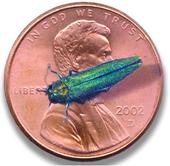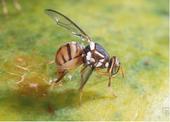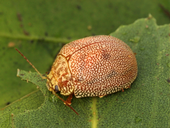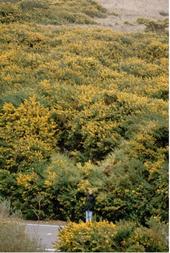- Author: Lauren Fordyce

Help increase public awareness of invasive species and encourage participation in the ongoing fight against invasive species by celebrating California Invasive Species Action Week (CISAW) June 1- 9, 2024.
Invasive species include non-native plants, animals, and pathogens that can negatively impact our waters, native ecosystems, agriculture, health, and economy. Every day this week, UC IPM will share information spotlighting a different invasive species, its impacts, and what you can do to help.
Keep an eye out for our upcoming blog posts and check out the resources below to learn more about invasive species:
- Read UC IPM's previous blog posts on
- Author: Belinda Messenger-Sikes

The emerald ash borer (EAB) may be beautiful, but it is the most destructive forest pest ever seen in North America. Hundreds of millions of ash trees across 36 states and 5 Canadian provinces have been killed by this invasive insect. Fortunately, EAB has not been found in California, but it was discovered in Oregon in 2022, the first time this insect has been detected on the West Coast.
Emerald Ash Borer Awareness Week is May 20-26th of 2024. During this week, the Don't Move Firewood campaign is offering SIX webinars over the first three days (May 20, 21, 22). Webinar topics include exciting...
- Author: Belinda Messenger-Sikes

The invasive pest spotlight focuses on emerging or potential invasive pests in California. In this issue we are covering the Oriental fruit fly.
Oriental Fruit Fly Facts
The Oriental fruit fly (OFF) is an invasive pest that attacks over 230 crops including citrus and other fruits, nuts, vegetables, and berries. The short life cycle of the OFF allows rapid development of serious outbreaks, which can cause severe economic losses. Heavy infestations can cause complete losses of crops. Fruit that has been attacked may be unfit to eat as larvae tunnel through the flesh as they feed. Fungi and bacteria enter, leaving the interior of the fruit a rotten mass. Infested fruit does not always...
- Author: Mackenzie Patton

Eucalypt trees have become abundant in the California landscape, but so have the many invasive eucalypt pests that have arrived in California in the last couple decades.
In the fall of 2022, yet another invasive pest was added to the hoard of beetles, psyllids, and gall wasps that attack eucalypt trees. The dotted paropsine leaf beetle (Paraopsis atomaria) was found on a lemon scented gum tree (Corymbia citriodora) in Los Angeles County. It was the first report of the dotted paropsine leaf beetle in North America, and it has since become more problematic throughout Southern California. Currently the extent of the spread is unknown.
Like eucalypt trees, the dotted paropsine leaf beetle is...
- Author: Mackenzie Patton

The Invasive Pest Spotlight focuses on relevant or emerging invasive species in California. In this issue we are covering brooms, a group of invasive shrubs.
Invasive Broom facts
Brooms are upright shrubs in the legume family that typically produce small, yellow, pea-shaped flowers. Shrubs range from 3 to 10 feet tall. They produce flowers from mid spring to summer and produce seed pods in late summer. All brooms are prolific seed producers, with a single shrub producing as many as 2,000 to 3,500 pods containing up to 20,000 seeds.
While brooms are attractive plants, they grow in dense stands that outcompete many native plants. These dense stands are highly...


